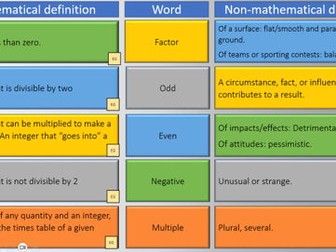
Literacy game for maths (or other subjects)
An interactive, touch-screen, “game-show”-style activity for ages 11-16. Students are challenged to match “Tier 2” subject words with their corresponding subject-specific definitions, and their definitions in other contexts.
e.g. “odd” can mean both “an integer that is not divisible by two” and “unusual or strange”.
The document includes over 80 such words for mathematics, grouped by topic (number, algebra, geometry, etc). along with their corresponding definitions. The document includes blank template slides with instructions on how to easily adapt the slides for any subject or age-group.
Perfect for plenaries, revision, tutor-time, or just filling a spare five minutes or so.
